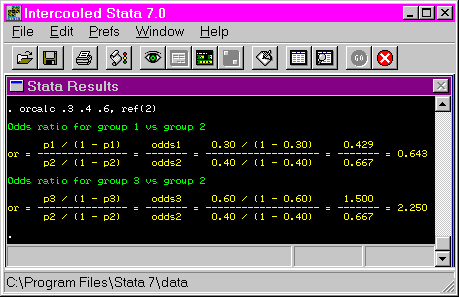Purpose: The purpose of this program is to calculate the odds ratio given the probabilities supplied by the user. The probability of Y = 1 for up to four levels of a categorical variable may be given. This program is useful for illustrating the relationship between these probabilities, the odds for each group and the odds ratio(s). The reference (or omitted) category may also be selected.
Download: You can download this program from within Stata by typing search orcalc (see How can I used the search command to search for programs and get additional help? for more information about using search).
Use of program: To use this program, type orcalc in the Stata command window. Up to four numbers may be given, but at least two are required. By default, the last group is used as the reference group (i.e., the omitted group). This can be changed with the ref(#) option, where the number specifies the number of the group to be used as the reference group.
Examples: The following shows the output from issuing the orcalc command. In this example, we assume that one is doing a logistic regression with a binary outcome variable and a predictor variable that has two categories. We assume that the probabilities for the two groups are .3 and 4. By default, orcalc uses the last group as the reference (or omitted) group. The program shows the formula for calculating the odds ratio, which is the odds of group 2 divided by the odds of group 1. To calculate the odds for group 2, .4 is divided by 1 – .4. The odds for group 1 is calculated by dividing .3 by 1 – .3, and the odds ratio, which is the ratio of the odds for group 2 divided by the odds for group 1, is .667 divided by .429, or 1.556.

The following shows the output from issuing the orcalc command, assuming that the predictor variable has three categories whose probabilities are .3, .4 and .6. Two odds ratios are calculated, one comparing group 2 to group 1, and one comparing group 3 to group 1. Again, the last group is used as the reference group.

This example is the same as the one above, except that we have used the ref(#) option to use the second group as the reference group. You will notice that this greatly changes both odds ratios.

The following shows the output from issuing the orcalc command, assuming that the predictor variable has four categories with probabilities of 3, .4, .6 and .7. Hence, three odds ratios are calculated, and because the ref(#) option was not used, the last group is used as the reference group.

